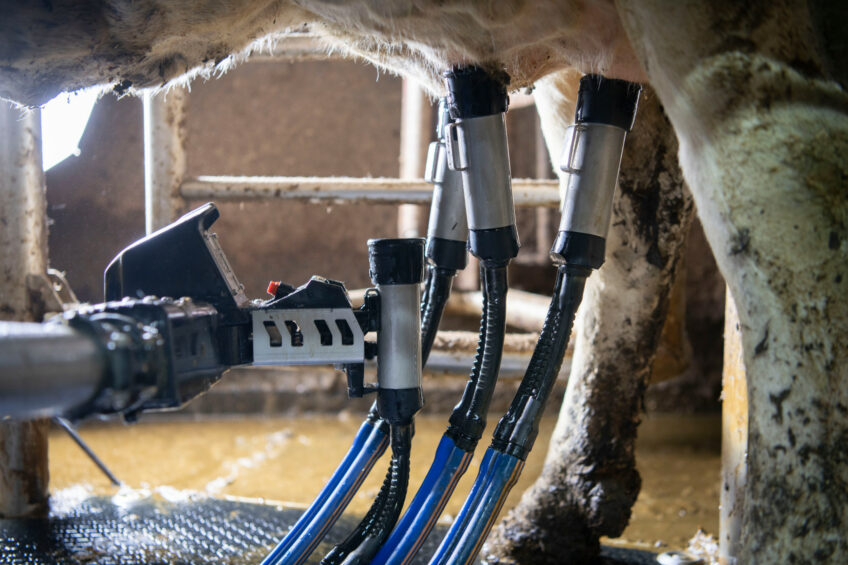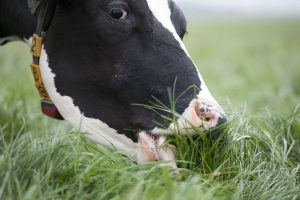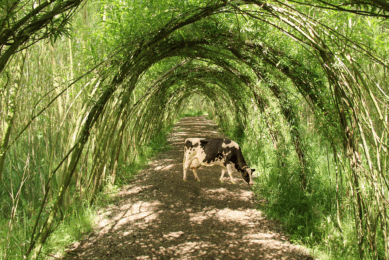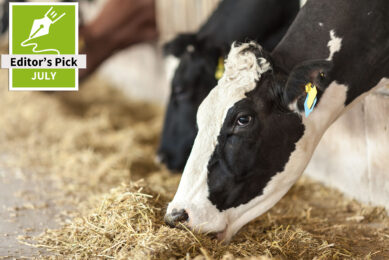Nutritional management when feeding cows through milking robots

Worldwide an increasing number of dairy cows are being fed through robot milking systems, but a closer look at how these cows are given the 2 components of their diet is needed. The aim is to ensure that they are each given the nutrition they need for maximum performance.
Cows in milking systems are given delicious pellets as they are milked in order to entice them to enter the milking area. They are also offered a high-quality forage-based ‘partial mixed ration’ (PMR) afterwards and at all times, which makes up the bulk of the diet. But it’s important to understand how much pellet consumption might affect how much and when cows consume the PMR, and also how pellet composition might have an effect. This is an area of dairy cattle nutrition that hasn’t received a great deal of attention. Forage quality in the PMR also affects PMR intake.
…if we can implement precision feeding…we can save money.”
We know that when the number of pellets given is increased cows don’t eat as much PMR. Sophia Cattleya Dondé, a PhD student under the supervision of Dr Greg B. Penner at the University of Saskatchewan in Canada, compares the gobbling up of pellets by cows and eating less PMR as a result to a person trying to eat as much dessert as possible and therefore eating less of their main meal.
Her ultimate goal is to support the growth of robotic milking by figuring out how to deliver the exact amount and profile of nutrients dairy cows need, stating that “if we can implement precision feeding…we can save money.” She also notes that of course, precision feeding of all livestock benefits the environment as well, with less nitrogen (for example) excreted by animals if they are provided the right amount of protein instead of too much.

Study details
In the first phase of her research, Dondé looked at how the amount of pellets and the pellet starch concentration affect the performance of lactating dairy cows. She fed cow groups pellets containing either 24% or 34% starch (noting that the lower percentage is the average used on Canadian dairy farms with robot milkers). In addition, some cows received either 2 kg or 6 kg of pellets per day, regardless of their production levels.
Whether the cows were given more or less starch in their pellets didn’t affect their performance.
But for cows given pellets with 24% starch, for every kg increase in pellets they consumed per day, cows in peak lactation reduced their PMR intake considerably– by 3.3 kg. But for every kg more of higher-starch pellets, cows only reduced their PMR intake by about a third of that, 1.18 kg.
With mid-lactation cows, it was the opposite. Cows at this point in their milking cycle who eat an extra kg of lower-starch pellets only reduced PMR intake by 0.18 kg, but with higher-starch pellets, there is a much-higher PMR reduction: 1.26 kg. “Interestingly,” adds Dondé, “late lactation cows don’t substitute at all when eating low-starch pellets and they substitute only 0.41 kg/d when eating high-starch pellets.”
As to why these results were seen, she explains that “a common theory is that the diet matters rather than just considering individual components. When factoring in the change in intake for the pellet and the corresponding change in PMR intake, there’s a smaller effect on total dietary starch than one might expect when hearing about the magnitude of change in the pellet starch. In our study, total dietary starch only differed by 0.67% between low-starch and high-starch in low allocation diets.”
Next, let’s look at studying protein in the pellet.
Dondé and her colleagues hypothesise that a higher or lower pellet protein concentration will not negatively affect PMR intake and milk and milk component yields. “In fact, we believe that high-protein pellets in robot milking systems might increase total dry matter intake and possibly increase milk yield,” she says.
Precision feeding
When asked how Dondé expects to deliver the exact amount and profile of nutrients dairy cows need, in terms of pellet versus PMR consumption levels, pellet percentage of diet, pellet composition and more, she first notes that there are many ways that diets can be formulated to achieve goals for an individual producer.
“I hope to highlight how changing the allocation and composition of the PMR and pellet components affects how cows consume nutrients in those fractions,” she explains. “Knowing this can help design effective and achievable diets to allow for precision feeding. Pretending that the allocation and composition of pellets doesn’t affect PMR intake is likely not true, and likewise pretending the PMR doesn’t affect pellet responses is also probably false. Given greater refusal and challenges delivering high quantities of pellets in robot systems, I think the effective range in pellet delivery is constrained.”
And while she believes we still need more studies on pellet composition, she notes that the feed industry is already changing this. “It looks like in Canada the pellet composition is moving to be more similar to the PMR than it used to be,” she notes, adding that “there is a wide variety of options and, depending on the forage resources and producer goals, those options should be able to meet producers’ needs.”
Other observations
Dr Trevor DeVries from the University of Guelph in Ontario has researched nutritional management of cows in robot systems for years and how it can be moved towards precision individualised feeding. In other words, to adjust the amount of pellets given to each cow or to add an additional supplement based on that cow’s stage of lactation, milk production, body weight and other factors.
He’s noted in the past that while there is some opportunity for precision feeding in robotic systems through the pellet, some cows are more comfortable than others with the robot systems and those that are less comfortable will eat fewer pellets. He also says some cows might not be able to consume all the pellets they are offered in a typical 7-to-8-minute milking.
Conversely, in a webinar in spring 2024, DeVries cautioned that when cows don’t get the maximum pellets they could consume while being milked, especially the highest-producing cows, it’s been observed that they will also eat less PMR at the feed bunk.
“And so, it becomes very important for us to realise that when we think about precision feeding options and try to maximise the opportunity in terms of maximising the peaks in cows and persistency in cows, for high-production cows that are eating a lot we need to make sure they are both optimising their nutrient intake at the feed bunk but also at the robot,” he stated. “And so, if we limit those cows in some scenarios, we’re actually limiting their total intake and their total production.”











